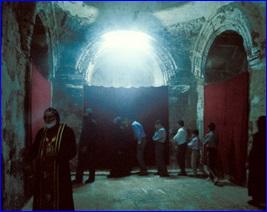Spotlight on the Eastern Churches: The Syriac Orthodox Church
 Resilient best describes the Syriac Orthodox Church. Persecuted by Byzantines, murdered by Mongols, massacred by Ottoman Turks and caught in the Kurdish-Turkish crossfire, Syriac Orthodox Christians [also known as Assyrians and Chaldeans] have managed to endure, preserving their legacy while enriching the entire church.
Resilient best describes the Syriac Orthodox Church. Persecuted by Byzantines, murdered by Mongols, massacred by Ottoman Turks and caught in the Kurdish-Turkish crossfire, Syriac Orthodox Christians [also known as Assyrians and Chaldeans] have managed to endure, preserving their legacy while enriching the entire church.
The Syriac Orthodox Church shares in the heritage of ancient Antioch, the commercial, cultural and political center of Rome's eastern Mediterranean province of Syria. Founded by St. Peter and nurtured by St. Paul, the church in Antioch emerged as the center of the church of the East, stretching beyond the borders of the Christian Roman (or Byzantine) Empire.
The development of the church of Antioch coincided with the confluence of cultures in the eastern Mediterranean world. Debates raged as Antioch's Christians explored the nature of Jesus, which prompted councils, the decrees of which drove a wedge between Antioch's Syriac-speaking Christians and Greek-speaking Christians allied with Byzantium.
Syriac Christians generally welcomed the Muslim Arabs invaders, who accepted them as "People of the Book." Safe from Byzantine authorities, Syriac scholars flourished. Poets fashioned hymns that simplified complex ideas. Scholars translated Greek texts and wrote biblical commentaries. Monks explored grammar, medicine, philosophy, rhetoric and science. Theologians and poets continued the tradition of composing liturgies, borrowing elements from other Christian traditions.
Drawn by this erudition, the Arabs employed Syriac scholars, who are largely responsible for the Arab world's familiarity with ancient Greek astronomy, chemistry, mathematics and philosophy -- disciplines that eventually reached Europe via Arab Sicily and Spain.
At its height in the mid-14th century, the Syriac Orthodox Church stretched from the Mediterranean to Afghanistan and included 20 metropolitan sees and more than a 100 eparchies. This golden age ended violently with the invasion of the Middle East by Timur the Lame in the 15th century. Those Syriac Christians who escaped death or enslavement retreated into the mountains, huddling in fortress-like monasteries and villages. Though scholarship did not vanish completely, isolation intensified, poverty set in and generation after generation of Syriac Orthodox families abjured their Christian faith.
Scholars estimate that by the beginning of the 20th century, fewer than 270,000 Syriac Orthodox Christians remained in Mesopotamia.
The trials for the church have only intensified in the last 100 years, even as membership has recovered: The church now counts as many as 5 million members, although two thirds live in India. In 1915 -- the "Year of the Sword" -- soldiers affiliated with the Ottoman authorities murdered more than 13,000 families and 150 priests. Survivors were deported or fled, many seeking refuge in Beirut, Damascus and Mosul. Some later settled in North America's burgeoning industrial cities.
Many of the families who fled to Baghdad, Beirut and Mosul as provincial peasants are now leaving as professionals for Europe, North America and Oceania. The emigration of Syriac Christians, who once formed the core of Syria and Iraq's middle classes, has created a regional "brain drain," as they establish new lives far from their historic center in the cradle of civilization.
Source: Western American Diocese of the Serbian Orthodox Church; Assyrian International News Agency (AINA)

